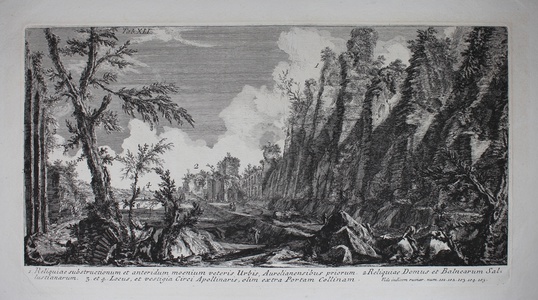| Method | Etching |
| Artist | Giovanni Battista Piranesi |
| Published | [Roma, 1762] |
| Dimensions | Image 198 x 402 mm, Plate 220 x 405 mm |
| Notes |
Plate XLI of Il Campo Marzio dell'Antica Roma, showing the substructure of the Servian Walls, the remains of some of the buildings of the Gardens of Sallust, and the location of the Circus Apollinaris, just outside the Colline Gate. Like much of the ancient city, the region between the Pincian and Quirinal Hills was heavily silted up by Piranesi's day, though, as the etching shows, excavation work was rapidly uncovering the archaeological interests of the area. The Horti Sallustiani, bought and developed by the Roman historian after the death of Julius Caesar, proved to be one of the most fertile sources of statuary and architectural inspiration in the century previous to Piranesi's own. The gardens were extensive, allowing Sallust and his circle with a green retreat from the noise and dust, while still being close enough to the political and social life of the ancient city. The right hand side of the scene is mostly occupied with the overgrown substructure of the ancient city walls, superceded by the walls erected by the emperor Aurelian, who also carried out significant improvements and alterations to the Gardens of Sallust, which since the time of Tiberius had been in the ownership of the emperor. Piranesi's Il Campo Marzio dell'Antica Roma was an ambitious attempt to document and study the extant Roman remains on the Field of Mars. An excellent illustration of the artist's talents as an architect and antiquarian, the work included maps of the area, views of principle monuments and ruins, as well as detailed illustrations of archaeological objects and fragments. Published in 1762, the Campo Marzio was dedicated to Piranesi's fellow architect, Robert Adam. Giovanni Battista (also Giambattista) Piranesi (1720 – 1778) was an Italian artist famous for his etchings of Rome and of fictitious and atmospheric "prisons" (the Carceri d'Invenzione). He was a major Italian printmaker, architect and antiquarian. The son of a Venetian master builder, he studied architecture and stage design, through which he became familiar with Illusionism. During the 1740's, when Rome was emerging as the centre of Neoclassicism, Piranesi began his lifelong obsession with the city's architecture. He was taught to etch by Giuseppe Vasi and this became the medium for which he was best known. Wilton-Ely 602, F471, C451a. Condition: Vertical printers crease to centre of image. Minor time toning to plate and platemark, otherwise a dark clean impression with full margins. Framed in an antique gilt frame. |
| Framing | framed |
| Price | £725.00 |
| Stock ID | 49599 |

